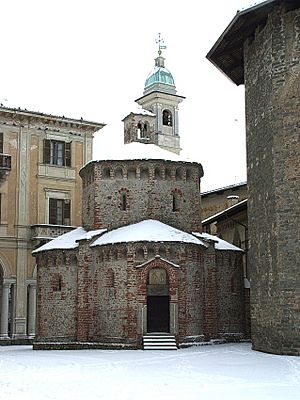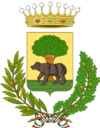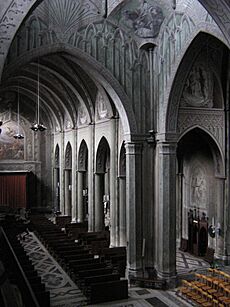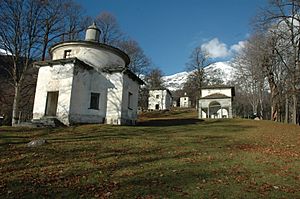Biella facts for kids
Quick facts for kids
Biella
Biela (Piedmontese)
|
||
|---|---|---|
| Comune di Biella | ||

Baptistery of Biella
|
||
|
||
| Country | Italy | |
| Region | Piedmont | |
| Province | Biella (BI) | |
| Frazioni | Barazzetto, Chiavazza, Colma, Cossila, Favaro, Lago del Mucrone, Oropa, Pavignano, Vaglio, Vandorno | |
| Area | ||
| • Total | 46.68 km2 (18.02 sq mi) | |
| Elevation | 420 m (1,380 ft) | |
| Population
(31-12-2017)
|
||
| • Total | 44,324 | |
| • Density | 949.53/km2 (2,459.27/sq mi) | |
| Demonym(s) | Biellese(i) | |
| Time zone | UTC+1 (CET) | |
| • Summer (DST) | UTC+2 (CEST) | |
| Postal code |
13900
|
|
| Dialing code | 015 | |
| Patron saint | St. Stephen | |
| Saint day | December 1 al January 30 | |
Biella is a city in northern Italy. It is located in the Piedmont region. Biella is the capital of its own province. About 44,000 people lived there in 2017. The city is about 80 kilometers (50 miles) northeast of Turin. It is also about the same distance west-northwest of Milan.
Biella sits at the foot of the Alps mountains. It is near Monte Mucrone and Monte Camino. This area has many springs and lakes. These are fed by melting glaciers. Several mountain streams flow through the area. These include the Elvo, Oropa river, and Cervo.
The city is known for its beautiful nature. You can visit the Zegna Viewpoint or the Bielmonte Ski Resort. The Burcina Natural Reserve is also nearby. The Sanctuary of Oropa is a very important religious site. In 2003, this sanctuary became a UNESCO World Heritage Site. This means it is a special place protected for everyone to enjoy.
Biella is a major center for processing wool and making textiles. Textiles are fabrics like cloth. There is also a small airport nearby in Cerrione.
Contents
History of Biella
How Biella Started
The first people in the Biella area were the Ligurians and Celts. We know this from old tools and items found there. They lived near streams and lakes. At first, they were fishermen and hunters. Later, they became herders, taking care of animals.
A group called the Victimuli lived in the Biella plain. They found gold in the Elvo river. People still look for gold there today as a hobby! Very old tools and necklaces have been found in the Burcina Reserve. These show that people lived in Biella a very long time ago.
Biella in the Middle Ages
The name Bugella (which became Biella) first appeared in a document from 826 AD. This document showed that Louis the Pious, a Holy Roman Emperor, gave Bugella to Count Busone. Later, in 882 AD, another document talked about land deals in the area.
In the 900s, people like the Alemanni, Lombards, and Franks lived in Biella. They built the first walls to protect the town from invaders. You can still see parts from this time. These include the old Romanesque Baptistry. The church of S. Stefano was also built then. The town grew around this church, which is now the cathedral.
In 1160, a bishop named Uguccione gave special trading rights to people living on Piazzo hill. He wanted to create a safe place during wars. This led to the creation of the Borgo del Piazzo. It has a beautiful public square called Piazza Cisterna.
In 1377, there was a revolt. Bishop Uguccione's castle was destroyed. Biella then came under the control of the House of Savoy.
Biella in Modern Times
In the 1300s and 1400s, the Visconti family and the House of Savoy fought over Biella. In the 1600s, French and Spanish forces also competed for the area. Biella was taken over by the French in 1704. In 1706, a soldier from Biella named Pietro Micca saved nearby Turin from a French attack. He gave his life to do so.
In 1798, the French took over Biella again. After a big battle, Biella officially became part of France. But after the Congress of Vienna, it was given back to the House of Savoy.
In 1859, the Austrians attacked Biella. But Giuseppe Garibaldi, a famous Italian leader, ended the attack. Biella then became part of the province of Novara. In 1927, it moved to the province of Vercelli.
During World War II, people in Biella bravely resisted the occupation. In 1992, Biella became its own province. This separated it from Vercelli.
The Wool Industry
Biella has a long history with wool. As early as 1245, rules for wool workers and weavers were written down. This makes sense because the area has high mountains for sheep. It also has lots of water for washing wool and powering mills.
In the 1600s and 1700s, silk was also important. A silk factory was built in Biella in 1695. But in 1835, that same building became a wool factory again. New machines for weaving wool were brought in. This made Biella a leader in the modern wool industry. Around 1999-2000, many wool factories in Biella closed. They couldn't compete with cheaper fabrics from other countries.
Culture in Biella
Biella is home to the Citta dell'arte (City of the Arts) - Fondazione Pistoletto. In 1994, an Italian artist named Michelangelo Pistoletto started a project. He wanted to connect art, creativity, and social life. In 1996, he opened the City of Arts. It is in an old textile factory near Biella. It is a place to support new ideas and creative projects. The City of Arts has different "Offices" for things like work, education, and art.
Main Places to See
- Biella Cathedral: The main church of the city.
- Biella Baptistery: An old building from the 900s or 1000s. It has old paintings inside.
- Giardino Botanico di Oropa: A beautiful garden with many plants.
- Sacro Monte and sanctuary of Oropa: A famous religious site and a UNESCO World Heritage Site.
- Biella Synagogue: A place of worship for the Jewish community.
- San Sebastiano Church: A church built in 1504.
- Oasi Zegna: A natural park where you can enjoy the outdoors.
Main Businesses and Brands
Biella is home to several well-known companies:
- Cerruti 1881: A famous clothing brand.
- Ermenegildo Zegna: Another well-known clothing brand.
- Vitale Barberis Canonico: Makes luxury fabrics.
- Fila: A popular sportswear company.
- Drago Lanificio in Biella: Makes high-quality fabrics.
- Banca Sella: A bank.
- Cassa di Risparmio di Biella e Vercelli: Another bank.
- Menabrea: A local beer company.
Getting Around Biella
Biella has two train stations. The main one is Biella San Paolo railway station. It connects trains going to Novara and Santhià. The second station, Biella Chiavazza railway station, is in the Chiavazza area.
There is also a special funicular in Biella. This is like a small train that goes up a steep hill. It connects the lower part of the city (Biella Piano) with the older, medieval part (Biella Piazzo).
The Biella-Cerrione Airport in Cerrione serves the city.
Biella Around the World
Biella is "twinned" with several cities around the world. This means they have a special friendship and cultural exchange.
Famous People from Biella
Many notable people have come from Biella:
- Leone Azzali (1880-1963): A politician.
- Virginia Angiola Borrino (1880–1965): The first woman to lead a University Pediatric Ward in Italy.
- Claudio Botosso (born 1958): An actor.
- Giovanni Bracco (1908–1968): A racing car driver.
- Antonio Brivio (1905–1995): A bobsledder and racing car driver.
- Tavo Burat (1932–2009): A teacher and journalist.
- Nino Cerruti (1930–2022): A famous fashion designer.
- Mario Gariazzo (1930–2002): An Italian screenwriter.
- Alberto Gilardino (born 1982): An Italian soccer player who won the FIFA World Cup.
- Piero Liatti (born 1962): A rally car driver.
- Pier Giorgio Morandi (born 1958): An Italian musician and conductor.
- Ugo Nespolo: An Italian painter and sculptor.
- Gabriele Piana (born 1986): A racing car driver.
- Michelangelo Pistoletto (born 1933): A famous artist.
- Elvina Ramella (1927–2007): An opera singer.
Images for kids
See also
 In Spanish: Biella para niños
In Spanish: Biella para niños








